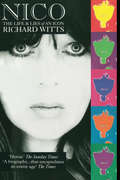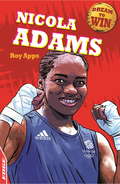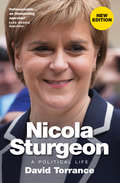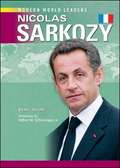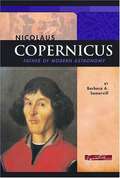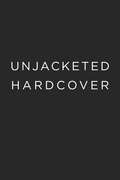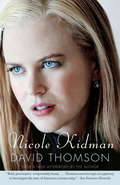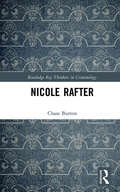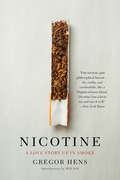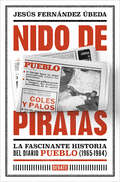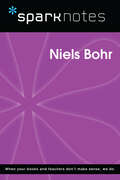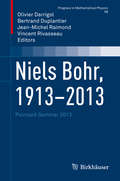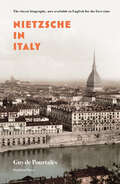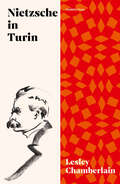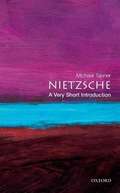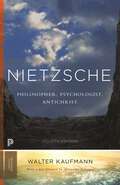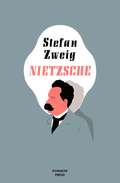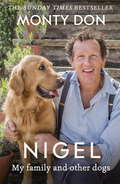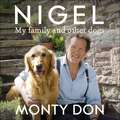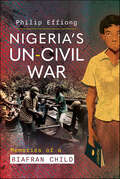- Table View
- List View
Nickie's Nook: Sharing the Journey
by Nickie CobyThrilling, frightening, amusing, deep, fearful, joyful and peaceful. All describe Nickie's Nook: Sharing the Journey. Through the use of essays, journal entries, papers and other reflections, Nickie's Nook explores the life of a young college student. Nickie uses writing to understand her journey as a person who is blind, person with chronic pain due to Complex Regional Pain Syndrome, a Guide Dog user and a member of humanity. In this book, she shares some of the best steps of her blogging journey.
Nico: Life And Lies Of An Icon
by Richard WittsNico was revered as ‘the most beautiful creature who ever lived’. She was Andy Warhol’s femme fatale and the High Preistess of Weird, yet few knew her real name or her wretched origins. When she called herself ‘a Nazi anarchist junkie’, they thought she was joking.Bob Dylan wrote a song about her, Jim Morrison a poem, Jean Baudrillard an essay, Andy Warhol a film, Ernest Hemingway a story – yet she fought against the idolatry of men to assert her independence as a composer of dissident songs.Nico’s contribution as an artist (17 films and 7 LPs) was smothered by gossip of her alleged affairs with men and women, whether Jimi Hendrix or Jeanne Moreau, Brian Jones of the Rolling Stones or Coco Chanel.She drifted through society like a phantom. Each era celebrated a different Nico – the top covergirl of the Fifties, the Siren of the Sixties (as The Times acclaimed her), the Moon Goddess of the Seventies, and the High Priestess of Punk when rock stars like Siouxsie Sioux and Pattie Smith acknowledged her pre-eminence. Ironically, they did so at the lowest point in her life. For behind the Garbo-esque veneer lived a lonely woman trying to stand autonomous in a fast-changing world, seeking to survive her heroin addiction and to cope with her tormented mother and her troubled son, his existence denied by his film-star father.In this pioneer biography, which Nico asked the author to write shortly before her outlandish death in 1988, Richard Witts uncovers the reasons for her subterfuge, and examines the facts surrounding her encounters with terrorist Andreas Baader, the Black Panthers, and the Society for Cutting Up Men. Exclusive contributions from artists such as Jackson Browne, Iggy Pop, Viva, John Cale, David Bailey, Siouxsie Sioux – and many others including her relatives, friends and enemies – make this the definitive biography of an icon who was not only a testament to an era but hitherto unrecognised influence on popular music and style.
Nicola Adams (EDGE: Dream to Win #17)
by Roy AppsNicola appeared in a BBC list of 100 top inspirational women, and reading her story you can see why. After joining an all-boys boxing club in Leeds, it soon became clear she was a natural. But then her mum became ill, and she had family responsibilities to take on, and her trainer couldn't get her a proper fight. How could Nicola continue to pursue her dream now? This is the story of how - with the spirit and determination of a champion - Nicola fought her way to the top of her sport.Dream to Win: Nicola Adams is written by expert author Roy Apps for kids with a reading age of 7 (but could also be enjoyed by pre-teens) and illustrated with black-and-white artwork. The stories focus on top athletes and sport personalities, with each dramatic story bringing to life the skill, determination and luck needed to break through into top level competition.This title is published by Franklin Watts EDGE, which produces a range of books to get children reading with confidence. EDGE - for books children can't put down.
Nicola Sturgeon: A Political Life
by David TorranceA biography of the Scottish leader by an author with &“an excellent eye for political detail&” (Scotland on Sunday). Nicola Sturgeon became involved in politics as a teenager, and then began a law career in Glasgow. She would go on to become Scotland&’s youngest parliamentary candidate in 1992, in her early twenties. Considered a rising star, she eventually reached the pinnacle of Scottish government as First Minister and leader of the Scottish National Party—the party she&’d joined at the age of sixteen. This book explores her reputation for efficiency and shrewd political judgment, her family life, and her role in the country&’s turbulent recent years with the campaign for Scottish independence from the United Kingdom and the Brexit vote. It is a portrait of a fascinating woman as well as an &“illuminating appraisal&” of her impressive career (Spectator).
Nicolas Sarkozy (Modern World Leaders)
by Dennis AbramsNicolas Sarkozy was born an outsider. A child of immigrants who grew up outside the circles of the French political elite, Sarkozy beat the odds by slowly climbing the political mountain until he reached France's highest peak--the office of the presidency. How did this awkward child from a broken home grow up to become the president of France? In Nicolas Sarkozy, explore what Sarkozy did to make it to the top and the political and personal price he paid to achieve his dreams.
Nicolaus Copernicus: Father of Modern Astronomy
by Barbara A. SomervillA biography profiling the life and controversial ideas of Nicolaus Copernicus, the founder of modern astronomy who through his observations of the stars and planets, discovered that the sun was the center of the universe, which challenged the teachings of the Roman Catholic Church. Includes source notes and timeline.
Nicole Brossard: Selections
by Nicole Brossard Jennifer MoxleyThis volume provides English-language readers with an overview of the life and work of Nicole Brossard, poet, novelist, and essayist, who is widely recognized in her native land and throughout the French-speaking world as one of the greatest writers of her generation.
Nicole Kidman
by David ThomsonFrom the brilliant film historian and critic David Thomson, a book that reinvents the star biography in a singularly illuminating portrait of Nicole Kidman--and what it means to be a top actress today. At once life story, love letter, and critical analysis, this is not merely a book about who Kidman is but about what she is--in our culture and in our minds, on- and offscreen. Tall, Australian, one of the striking beauties of the world, Nicole Kidman is that rare modern phenomenon--an authentic movie star who is as happy and as creative throwing a seductive gaze from some magazine cover as she is being Virginia Woolf inThe Hours. Here is the story of how this actress began her career, has grown through her roles, taken risks, made good choices and bad, and worried about money, aging, and image. Here are the details of an actress's life: her performances inTo Die For, The Portrait of a Lady, Eyes Wide Shut, Moulin Rouge!, The Hours,andBirth,among other films; her high-visibility marriage to Tom Cruise; her intense working relationship with Stanley Kubrick and her collaborations with Anthony Minghella and Baz Luhrmann; her work with Jude Law, Anthony Hopkins, Renée Zellweger, and John Malkovich; her decisions concerning nudity, endorsements, and publicity. And here are Thomson's scintillating considerations of what celebrity means in the life of an actress like Kidman; of how the screen becomes both barrier and open sesame for her and for her audience; of what is required today of an actress of Kidman's stature if she is to remain vital to the industry and to the audiences who made her a prime celebrity. Impassioned, opinionated, dazzlingly original in its approach and ideas,Nicole Kidmanis as alluring and as much fun as Nicole Kidman herself, and David Thomson's most remarkable book yet.
Nicole Rafter (Routledge Key Thinkers in Criminology)
by Chase BurtonThis book is a critical summary and exegesis of the work of Nicole Rafter, who was a leading scholar of the history of biological theories of crime causation as well as a profound theorist of the role of history within criminology. It introduces Rafter’s key works and assesses her contributions to the fields of feminist criminology, cultural criminology, visual criminology and historical criminology. It also explores her theorization of criminology’s identity, scientific status, and possible futures. While many books on criminological theory explain and historically contextualize theory, they do not interrogate the production of theory or the epistemological assumptions behind it. Drawing on the world of Nicole Rafter, this book offers an accessible handbook to her extensive historical studies and to how her work demonstrated the importance of historical theory to criminological knowledge. Furthermore, the author brings Rafter’s historical research to life and shows how it speaks to contemporary issues in criminology and punishment. Written in a clear and direct style, this book will appeal to students and scholars of criminological theory, intellectual history, sociology, comparative criminology, and feminist criminology.
Nicotine
by Will Self Gregor Hens Jen CallejaBy turns philosophical and darkly comic, an ex-smoker's meditation on the nature and consequences of his nearly lifelong addiction Written with the passion of an obsessive, Nicotine addresses a lifelong addiction, from the thrill of the first drag to the perennial last last cigarette. Reflecting on his experiences as a smoker from a young age, Gregor Hens investigates the irreversible effects of nicotine on thought and patterns of behavior. He extends the conversation with other smokers to meditations on Mark Twain and Italo Svevo, the nature of habit, and the validity of hypnosis. With comic insight and meticulous precision, Hens deconstructs every facet of dependency, offering a brilliant analysis of the psychopathology of addiction. This is a book about the physical, emotional, and psychological power of nicotine as not only an addictive drug, but also a gateway to memory, a long trail of streetlights in the rearview mirror of a smoker's life. Cigarettes are sometimes a solace, sometimes a weakness, but always a witness and companion. This is a meditation, an ode, and a eulogy, one that will be passed hand-to-hand between close friends.
Nido de piratas: La fascinante historia del diario Pueblo (1965-1984)
by Jesús Fernández ÚbedaLas extraordinarias andanzas del diario Pueblo que, entre 1965 y 1984, congregó a las mayores leyendas del periodismo. «Aprendí el oficio en aquel asombroso nido de piratas que este magnífico libro de Jesús Fernández Úbeda, que sin duda habría sido uno de los nuestros, rescata del olvido».Arturo Pérez-Reverte, en el prólogo«En el pan, como hermanos; en la información, como gitanos». Nido de piratas es una historia del diario Pueblo, que comienza en 1964, cuando el periódico de los sindicatos verticales se traslada al número 73 de la madrileña calle de las Huertas. Bajo la batuta de Emilio Romero, y con una tirada de más de doscientos mil ejemplares, se encuentra en la cima del éxito. Entre whiskys, partidas de póker y una nube de humo de tabaco negro, se oye el inconfundible repiqueteo de las teclas de las Olivettis. Los reporteros y fotógrafos que se pelean por las exclusivas se cuentan por decenas. Y están dispuestos a todo. Así lo recuerdan en este libro muchos de los que por allí pasaron. Desde Arturo Pérez-Reverte hasta Rosa Villacastín, Carmen Rigalt, Raúl del Pozo, Julia Navarro (y su padre, Felipe Navarro, Yale) o Andrés Aberasturi. Pero también otros -abogados, curas, fotógrafos, peluqueros, etc.-, testigos directos de esa manera salvaje y apasionante de hacer periodismo.Pueblo, herido de muerte tras la salida de Romero, reacciona de forma tardía al golpe de Estado de Tejero, y sufre un fuerte recorte de plantilla y pérdidas millonarias. Aquel transatlántico en proceso de desguace se hunde irremediablemente. Esa parte de la historia, por desgracia, no parece tan ajena. Sus puertas cierran de forma definitiva en 1984, cuando el Gobierno de Felipe González termina de ejecutar el plan de Suárez de acabar con la prensa pública. Y, con él, desaparece una manera única, voraz y trepidante de entender el oficio. Críticas:«No es sólo el retrato de una forma de hacer periodismo que ya no existe, sino también de una forma de vivir que está desapareciendo a marchas forzadas».Enrique Bunbury «Un libro apasionante que refleja la vida de unos bucaneros, lo peor de cada casa, que se mataban por aparecer en primera página».Raúl del Pozo «Para casi todos los que conocían Pueblo, trabajar allí era como vivir una segunda infancia feliz».José María García«Llegué a colaborar unas cuantas veces en el inefable diario Pueblo que mi admirado Jesús Úbeda ha estudiado a la perfección en este libro ejemplar, a la vez una crónica de aquel filibusterismo periodístico que hoy añoramos tanto y un trabajo bien concebido y mejor rematado».Luis Alberto de Cuenca
Niels Bohr (SparkNotes Biography Guide)
by SparkNotesNiels Bohr (SparkNotes Biography Guide) Making the reading experience fun! SparkNotes Biography Guides examine the lives of historical luminaries, from Alexander the Great to Virginia Woolf. Each biography guide includes:An examination of the historical context in which the person lived A summary of the person&’s life and achievements A glossary of important terms, people, and events An in-depth look at the key epochs in the person&’s career Study questions and essay topics A review test Suggestions for further reading Whether you&’re a student of history or just a student cramming for a history exam, SparkNotes Biography guides are a reliable, thorough, and readable resource.
Niels Bohr, 1913-2013
by Vincent Rivasseau Olivier Darrigol Bertrand Duplantier Jean-Michel RaimondThis fourteenth volume in the Poincaré Seminar Series is devoted to Niels Bohr, his foundational contributions to understanding atomic structure and quantum theory and their continuing importance today. This book contains the following chapters: - Tomas Bohr, Keeping Things Open; - Olivier Darrigol, Bohr's Trilogy of 1913; -John Heilbron, The Mind that Created the Bohr Atom; - Serge Haroche & Jean-Michel Raimond, Bohr's Legacy in Cavity QED; - Alain Aspect, From Einstein, Bohr, Schrödinger to Bell and Feynman: a New Quantum Revolution?; - Antoine Browaeys, Interacting Cold Rydberg Atoms: A Toy Many-Body System; - Michel Bitbol & Stefano Osnaghi, Bohr´s Complementarity and Kant´s Epistemology. Dating from their origin in lectures to a broad scientific audience these seven chapters are of high educational value. This volume is of general interest to physicists, mathematicians and historians.
Nietzsche in Italy
by Guy De PourtalesA fascinating classic account of Nietzsche's travels in Italy at the end of the nineteenth century, where he found inspiration for his major works First published in 1929, Nietzsche in Italy has never been out of print in France but has never been translated into English until now.Endlessly fascinating and highly readable, Nietzsche in Italy will enthrall anyone interested in Nietzsche's relationship with the country that enriched his soul more than any other. For fifteen years, after his first visit to the country in 1876, Nietzsche was repeatedly and irresistibly drawn back to Italy's climate and lifestyle. It was there that he composed his most famous works, including Thus Spake Zarathustra and Ecce Homo. This classic biography follows the troubled philosopher from Rome, to Florence, via Venice, Sorrento, Genoa, Sicily and finally to the tragic denouement in Turin, the city in which Nietzsche found a final measure of contentment before his irretrievable collapse.
Nietzsche in Turin: The End of the Future
by Lesley ChamberlainBeautifully packaged reissue of the vividly lyrical biography of Nietzsche that John Banville called 'a major intellectual event'In 1888, philosopher Friedrich Nietzsche moved to Turin. This would be the year in which he wrote three of his greatest works: Twilight of the Idols, The Antichrist, and Ecce Homo; it would also be his last year of writing. He suffered a debilitating nervous breakdown in the first days of the following year. In this probing, elegant biography of that pivotal year, Lesley Chamberlain undoes popular clichés and misconceptions about Nietzsche by offering a deeply complex approach to his character and work. Focusing as much on Nietzsche's daily habits, anxieties and insecurities as on the development of his philosophy, Nietzsche in Turin offers a uniquely lively portrait of the great thinker, and of the furiously productive days that preceded his decline.
Nietzsche'S anti-Darwinism
by Dirk R. JohnsonFriedrich Nietzsche's complex connection to Charles Darwin has been much explored, and both scholarly and popular opinions have tended to assume a convergence in their thinking. In this study, Dirk Johnson challenges that assumption and takes seriously Nietzsche's own explicitly stated "anti-Darwinism. " He argues for the importance of Darwin for the development of Nietzsche's philosophy, but he places emphasis on the antagonistic character of their relationship and suggests that Nietzsche's mature critique against Darwin represents the key to understanding his broader (anti-)Darwinian position. He also offers an original reinterpretation of the Genealogy of Morals, a text long considered sympathetic to Darwinian naturalism, but which he argues should be taken as Nietzsche's most sophisticated critique of both Darwin and his followers. His book will appeal to all who are interested in the philosophy of Nietzsche and its cultural context.
Nietzsche's Sister and the Will to Power: A Biography of Elisabeth Förster-Nietzsche (International Nietzsche Studies)
by Carol DietheA penetrating study of the sister who betrayed and endangered her famous brother's legacy In 1901, a year after her brother Friedrich's death, Elisabeth Förster-Nietzsche published The Will to Power, a hasty compilation of writings he had never intended for print. In Nietzsche's Sister and the Will to Power, Carol Diethe contends that Förster-Nietzsche's own will to power and her desire to place herself--not her brother--at the center of cultural life in Germany are centrally responsible for Nietzsche's reputation as a belligerent and proto-Fascist thinker. Offering a new look at Nietzsche's sister from a feminist perspective, this spirited and erudite biography examines why Elisabeth Förster-Nietzsche recklessly consorted with anti-Semites, from her own husband to Hitler himself, out of convenience and a desire for revenge against a brother whose love for her waned after she caused the collapse of his friendship with Lou Salomé. The book also examines their family dynamics, Nietzsche's dismissal of his sister's early writing career, and the effects of limited education on intelligent women. Diethe concludes by detailing Förster-Nietzsche's brief marriage and her subsequent colonial venture in Paraguay, maintaining that her sporadic anti-Semitism was, like most things in her life, an expedient tool for cultivating personal success and status. A volume in the series International Nietzsche Studies, edited by Richard Schacht
Nietzsche: A Very Short Introduction
by Michael TannerFriedrich Nietzsche (1844-1900) was a German philosopher, almost wholly neglected during his sane life, which came to an abrupt end early in 1889. 'Nietzsche' is the figure in whose name people of the most astonishingly discrepant and various views have sought to find justification for them.
Nietzsche: Philosopher, Psychologist, Antichrist (Princeton Classics #3)
by Walter A. KaufmannThis classic is the benchmark against which all modern books about Nietzsche are measured. When Walter Kaufmann wrote it in the immediate aftermath of World War II, most scholars outside Germany viewed Nietzsche as part madman, part proto-Nazi, and almost wholly unphilosophical. Kaufmann rehabilitated Nietzsche nearly single-handedly, presenting his works as one of the great achievements of Western philosophy. Responding to the powerful myths and countermyths that had sprung up around Nietzsche, Kaufmann offered a patient, evenhanded account of his life and works, and of the uses and abuses to which subsequent generations had put his ideas. Without ignoring or downplaying the ugliness of many of Nietzsche's proclamations, he set them in the context of his work as a whole and of the counterexamples yielded by a responsible reading of his books. More positively, he presented Nietzsche's ideas about power as one of the great accomplishments of modern philosophy, arguing that his conception of the "will to power" was not a crude apology for ruthless self-assertion but must be linked to Nietzsche's equally profound ideas about sublimation. He also presented Nietzsche as a pioneer of modern psychology and argued that a key to understanding his overall philosophy is to see it as a reaction against Christianity. Many scholars in the past half century have taken issue with some of Kaufmann's interpretations, but the book ranks as one of the most influential accounts ever written of any major Western thinker. Featuring a new foreword by Alexander Nehamas, this Princeton Classics edition of Nietzsche introduces a new generation of readers to one the most influential accounts ever written of any major Western thinker.
Nietzsche: The Struggle With The Daemon (Master Builders Of The Spirit Ser.)
by Stefan ZweigA scintillating biographical study of the one of the greatest philosophers of the nineteenth century, by one of the bestselling writers of the twentieth.In this vivid biography, Zweig eschews traditional academic discussion and focuses on Nietzsche's habits, passions and obsessions. This work, concentrating on the man rather than the work, on the tragedy of his existence and his apartness from the world in which he moved in enforced isolation, is a tour de force, drawing the reader inexorably into Nietzsche's tragic trajectory.Illustrated with numerous photographs relating to Nietzsche and his European locations, this superb translation by Will Stone is essential reading for anyone interested in Nietzsche, Zweig, first-class biographies and philosophy.
Nigel Dempster and the Death of Discretion: The Life And Legacy Of The World's Greatest Gossip
by Tim WillisNo one is more responsible for Britain"s current obsession with celebrity culture than the late, great gossip columnist Nigel Dempster (1941-2007). For a quarter of a century, as the editor of the Daily Mail"s diary, he was the man perfectly placed and qualified to record - and accelerate - the end of the age of deference.
Nigel: my family and other dogs
by Monty DonTHE SUNDAY TIMES BESTSELLEWhen Monty Don's golden retriever Nigel became the surprise star of BBC Gardeners' World, inspiring huge interest, fan mail and his own social media accounts, Monty Don wanted to explore what makes us connect with animals quite so deeply. In many respects Nigel was a very ordinary dog; charming, handsome and obedient, as so many are. He was a much loved family pet. He was also a star. By telling Nigel's story, Monty relates his relationships with the other special dogs in his life in a memoir of his dogs past and very much present. Since it was first released in 2016, Monty Don's Nigel: my family and other dogs has sold over a quarter of a million copies, with Nigel, who sadly passed away in 2020, ensuring his place in the hearts of readers and dog lovers everywhere. This life-affirming memoir of the importance of dogs in Monty's life and in all our lives, is never more true than now.'I have always had a dog, or dogs. I cannot imagine life without them. I am just as much a fan of Nigel as any besotted viewer. In the book I explore why we love dogs and what they mean to us emotionally and domestically. I look back on all the dogs in my life - all of which I have loved deeply and which have been an essential part of my life. So, this is the book of Nigel - but also the book of all our dogs in every British family and a celebration of the deep love we feel for them' Monty Don
Nigel: my family and other dogs
by Monty DonTHE SUNDAY TIMES BESTSELLERWhen Monty Don's golden retriever Nigel became the surprise star of BBC Gardeners' World, inspiring huge interest, fan mail and his own social media accounts, Monty Don wanted to explore what makes us connect with animals quite so deeply. In many respects Nigel was a very ordinary dog; charming, handsome and obedient, as so many are. He was a much loved family pet. He was also a star. By telling Nigel's story, Monty relates his relationships with the other special dogs in his life in a memoir of his dogs past and very much present. Since it was first released in 2016, Monty Don's Nigel: my family and other dogs has sold over a quarter of a million copies, with Nigel, who sadly passed away in 2020, ensuring his place in the hearts of readers and dog lovers everywhere. This life-affirming memoir of the importance of dogs in Monty's life and in all our lives, is never more true than now.'I have always had a dog, or dogs. I cannot imagine life without them. I am just as much a fan of Nigel as any besotted viewer. In the book I explore why we love dogs and what they mean to us emotionally and domestically. I look back on all the dogs in my life - all of which I have loved deeply and which have been an essential part of my life. So, this is the book of Nigel - but also the book of all our dogs in every British family and a celebration of the deep love we feel for them' Monty Don
Nigel: my family and other dogs
by Monty DonWhen Monty Don's golden retriever Nigel became the surprise star of BBC Gardeners' World inspiring huge interest, fan mail and even his own social media accounts, Monty Don wanted to explore what makes us connect with animals quite so deeply. In many respects Nigel is a very ordinary dog; charming, handsome and obedient, as so many are. He is also a much loved family pet. He is also a star. By telling Nigel's story, Monty relates his relationships with other special dogs in his life in a memoir of his dogs past and very much present. Witty, touching and life-affirming, Nigel: My family and other dogs is wonderfully heart-warming. Monty Don is a great writer coming out of the garden and into the hearts and homes of every dog lover in the UK.'I have always had a dog, or dogs. I cannot imagine life without them. I am just as much a fan of Nigel as any besotted viewer. In the book I explore why we love dogs and what they mean to us emotionally and domestically. I look back on all the dogs in my life - all of which I have loved deeply and which have been an essential part of my life. So, this is the book of Nigel - but also the book of all our dogs in every British family and a celebration of the deep love we feel for them' Monty Don(P) 2016 Hodder & Stoughton Limited
Nigeria's Un-Civil War: Memories of a Biafran Child
by Philip Effiong"The peace had been desecrated. I knew because people spoke in low tones and laughter dried up. Outside, things unfolded without grace or color, even the harmattan leaves were more skeletal than usual. The sun still shone but didn’t smile; it was as if it could tell that the worst was yet to come. Change should not have been bad, but this one was heavy and stubborn. Months later I learned about the 15 January 1966 coup d’état." In Nigeria’s un-Civil War: Memories of a Biafran Child, Philip Effiong reveals the many characters of war: the horror and the chaos, the surrealism and the absurdity and the desperate need to conjure a semblance of normalcy against a backdrop of air raids, starvation and massacre. This is his, and his family’s, story before, during and after the Biafra–Nigeria War of July 1967 to January 1970. He begins in Lagos with the January 1966 coup and describes his high-ranking military father’s narrow assassination escape at the hands of the executors of the second coup six months later. Flight and relocation dog the next three-and-a-half years as his family tries to maintain a sense of stability amid crumbling education, health services and failing infrastructure. Lessons in literacy and numeracy are exchanged for creativity in foraging as food becomes ever scarcer. Death, fear, destitution and the madness in which the family repeatedly finds itself are told obliquely through a child’s eyes and leave the reader gutted by the senselessness and cruelty of war, yet equally buoyed by the resilience of the Biafran people’s inextinguishable hope.

